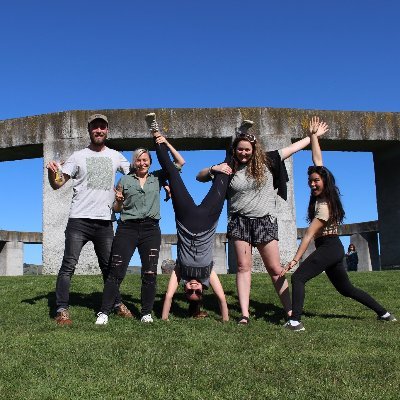
stonehengeaotearoa
@nzstonehenge
Followers
4
Following
0
Media
226
Statuses
238
The official Twitter for the New Zealand Stonehenge.
Joined April 2022
Ever wonder how the stones were placed? Each one is carefully aligned to match celestial events in NZ’s sky. It’s a living calendar in stone. Come see how sky and landscape unify: https://t.co/FK8iMaJEAK
#StonehengeNZ #AstronomyDesign #BehindTheScenes
0
0
0
Ever wonder how the stones were placed? Each one is carefully aligned to match celestial events in NZ’s sky. It’s a living calendar in stone. Come see how sky and landscape unify: https://t.co/FK8iMaJEAK
#StonehengeNZ #AstronomyDesign #BehindTheScenes
0
0
0
“Somewhere, something incredible is waiting to be known.” – Carl Sagan. The cosmos has always inspired curiosity. At Stonehenge Aotearoa, those stories are brought down to earth. Find your connection: https://t.co/dseFBCOBnY
#CarlSagan #StonehengeNZ #StarKnowledge
0
0
0
Tired of the same weekend plans? At Stonehenge Aotearoa, you’ll uncover mysteries of the universe. Visitors call it “fascinating” and “unlike anywhere else in NZ.” Tag a friend and book now: https://t.co/dseFBCOBnY
#CosmicAdventures #StonehengeNZ #Wairarapa
0
0
0
The stars aren’t just lights in the sky—they’re storytellers. Māori star lore guided planting, navigation, and cultural traditions. This spring, Orion and Taurus return, carrying stories of renewal. More stories at https://t.co/dseFBCOBnY
#Matariki #MāoriAstronomy #StonehengeNZ
0
0
0
Ever wondered how ancient people tracked the seasons? They followed the sun’s path across the horizon—just like the solar alignments here. Imagine standing where the sky itself marks solstices and equinoxes. Discover it yourself: https://t.co/dseFBCOBnY
#AstronomyNZ #StonehengeNZ
0
0
2
Join us on November 15 at Stonehenge Aotearoa for a one-of-a-kind experience — Voyager 2, a classical performance by Keith Austin, inspired by humanity’s legendary journey to the stars. ✨ 🔗 Learn more or plan your visit: https://t.co/FTRFcCD7lw
#StonehengeAotearoa #Voyager2
0
0
0
Step into a place where time, space, and sky connect. At Stonehenge Aotearoa, every stone is perfectly aligned to the sun, moon, and stars. Visitors say it feels like walking into the past while glimpsing the future. Book your visit today: https://t.co/dseFBCOBnY
#StonehengeNZ
0
0
0
Could We Live Beyond Earth? Scientists have discovered over 5,600 exoplanets — and a handful may be habitable. 🪐 While Earth is our only true home, the search for life beyond continues. As #WorldSpaceWeek ends, we carry forward humanity’s greatest question.
0
0
0
As #WorldSpaceWeek comes to a close, we’re reminded that the sky is not the limit — it’s the beginning. Explore the stars and your place in the cosmos at Stonehenge Aotearoa. 👉 Book your visit: https://t.co/FK8iMaJEAK
#WorldSpaceWeek2025 #Astronomy #StonehengeAotearoa
0
0
0
The Challenges of Living Beyond Earth Space looks peaceful… but survival there is tough. Radiation, lack of oxygen, and extreme cold are just some of the challenges astronauts must overcome. Scientists design suits, habitats, and shields to keep us safe.
0
0
0
Astronaut Jobs You Never Knew Existed You don’t need to be a pilot to work in space. 🚀 NASA hires toilet engineers, flight surgeons, and planetary protection officers to keep missions running. 🌌 Real jobs with out-of-this-world responsibilities! #SpaceCareers #WorldSpaceWeek
0
0
0
Dark Sky Reserves on Earth Want skies as dark as space? 🌌 You don’t need a rocket — New Zealand’s Wairarapa offers some of the darkest skies in the world. Come and experience them at Stonehenge Aotearoa. ✨ 📍 Open Wed–Sun, 10–4. 👉 https://t.co/FK8iMaJEAK
#DarkSkyReserve
0
0
0
Could Mars be humanity’s “second Earth”? NASA rovers are testing soil, climate, and water history to see if Mars could support future colonies. Discover how ancient cultures looked to Mars as a fiery god of war — and how modern science sees it as a possible home.
0
0
0
The First Human in Space Before the Moon landing, there was one man: Yuri Gagarin. 🌍 In 1961, he became the first human to orbit Earth — sparking the space age we live in today. 🚀 📍 Explore humanity’s cosmic journey 👉 https://t.co/FK8iMaJEAK
#SpaceHistory #WorldSpaceWeek
0
0
0
“A Hidden Gem — and Dog Friendly!” Sometimes the best adventures are the ones you stumble across. One happy guest said: “Never heard of this place before we saw some road signs. Great place and educational — and dog friendly!” Plan your visit today: https://t.co/FTRFcCD7lw
0
0
0
What’s It Like to Sleep in Space? Imagine drifting to sleep with Earth glowing below you. Astronauts sleep strapped to walls so they don’t float away! NASA studies sleep cycles in space to help humans adjust on long missions. Join us this World Space Week: https://t.co/FTRFcCD7lw
0
0
0
What Happens to Your Body in Space? Space changes the human body. 🧑🚀 Without gravity, bones weaken, muscles shrink, and fluids shift to the head. That’s why astronauts train so hard to stay healthy in orbit. 🌌 #SpaceHealth #WorldSpaceWeek #AstronomyNZ
0
0
0
Ever wanted to truly understand the stars above you? A recent visitor shared: “Richard and Kay are so knowledgeable and shared fascinating facts about the stars. Great viewing too.” Join us to explore the science and stories of the night sky Book here: https://t.co/FTRFcCD7lw
0
0
0
Sleeping in Space vs Earth Astronauts don’t have beds — they strap into sleeping bags that float inside the ISS. 😴 Compare that to lying down on Earth, and you’ll see just how different life in space really is! 👉 https://t.co/FK8iMaJEAK
#LivingInSpace #AstronomyTikTok
0
0
0